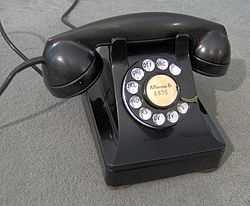Henry Dreyfuss

.jpg)


Henry Dreyfuss (/ˈdraɪfəs/; March 2, 1904 – October 5, 1972) was an American industrial designer.
Career
Dreyfuss was a native of Brooklyn, New York. As one of the celebrity industrial designers of the 1930s and 1940s, Dreyfuss dramatically improved the look, feel, and usability of dozens of consumer products. As opposed to Raymond Loewy and other contemporaries, Dreyfuss was not a stylist: he applied common sense and a scientific approach to design problems. His work both popularized the field for public consumption, and made significant contributions to the underlying fields of ergonomics, anthropometrics, and human factors. Until 1920 Dreyfuss studied as an apprentice to theatrical designer Norman Bel Geddes, his later competitor, and opened his own office in 1929 for theatrical and industrial design activities. It was an immediate and long-lasting commercial success. As of 2005 his firm continues to operate as Henry Dreyfuss Associates with major corporate clients.
Designs
Significant original Dreyfuss designs include:
- the "Western Electric 302" tabletop telephone for Bell Laboratories (1930, produced 1937-1950)
- the Hoover "Model 150" vacuum cleaner (1936)
- the classic Westclox "Big Ben" alarm clock (1939)
- the New York Central Railroad's streamlined Mercury train, both locomotive and passenger cars (1936)
- the NYC Hudson locomotive for the "Twentieth Century Limited" (1938)
- the popular "Democracity" model city of the future at the 1939 New York World's Fair at the Trylon and Perisphere
- the styled John Deere Model A and Model B tractors (1938)
- the Wahl-Eversharp Skyline fountain pen (1940)
- the Royal Typewriter Company's Quiet DeLuxe (late 1940s)
- the "500" desk telephone (1949), a Bell System standard for years
- the two American steamships, S.S. Independence and S.S. Constitution for American Export Lines (1951-2)
- the Honeywell T87 circular wall thermostat (1953)
- the spherical Hoover model 82 Constellation vacuum cleaner which floated on an air cushion of its own exhaust (1954)
- the Hoover model 65 convertible vacuum cleaner (1957)
- the "Princess" telephone (1959)
- the Bankers Trust Building at 280 Park Avenue in Manhattan, New York City, with Emery Roth & Sons (1963)[1]
- the "Trimline" desk telephone (1965)
- the Polaroid SX-70 Land camera (1972)
Later life
In 1955, Dreyfuss wrote Designing for People, an autobiography which features his "Joe" and "Josephine" simplified anthropometric charts. In 1960 he published The Measure of Man, an ergonomic reference. Nine years later, in 1969, he left the firm he founded.[2]
Dreyfuss was the first President of the Industrial Designers Society of America (IDSA).
Death
On October 5, 1972, at their home in South Pasadena, California, Dreyfuss and his wife, Doris Marks, who was terminally ill, committed suicide. They were found in a car, killed by self-inflicted carbon monoxide poisoning. Earlier that year, Marks had been diagnosed with liver cancer. The design company, Henry Dreyfuss Associates, remains after his death.
References
Notes
- ↑ White, Norval; Willensky, Elliot & Leadon, Fran (2010). AIA Guide to New York City (5th ed.). New York: Oxford University Press. ISBN 9780195383867., p.317
- ↑ Henry Dreyfuss Associates | People | Collection of Smithsonian Cooper-Hewitt, National Design Museum
Bibliography
- Dreyfuss, Henry. Symbol Sourcebook: An Authoritative Guide to International Graphic Symbols. New York: John Wiley & Sons. 1984. ISBN 0-471-28872-1
- Dreyfuss, Henry. Designing for People. Allworth Press; illustrated edition, 2003. ISBN 1-58115-312-0
- Flinchum, Russell. Henry Dreyfuss, Industrial Designer: The Man in the Brown Suit. Rizzoli, 1997. ISBN 0-8478-2010-6
- Innes, Christopher. Designing Modern America: Broadway to Main Street. Yale University Press, 2005. ISBN 0-300-10804-4
External links
| Wikimedia Commons has media related to Henry Dreyfuss. |
- Henry Dreyfuss Associates website
- Video on Dreyfuss's design for Honeywell thermostat and for his Bell Telephone, at Wikimedia Commons
|